Are you considering using Grammarly to improve your writing? Debating what plan is the best for you? This guide to Grammarly free vs premium is here to help.
👉 I’ll compare the free and premium versions of this AI writing assistant in three categories:
I’ll then talk a bit about Grammarly and data privacy and, based on everything we’ve learned together, share when you should use Grammarly free vs Grammarly Premium and when you should consider using an alternative. Let’s dive into it! 🪂
Features ⚙️

The most important thing to consider in the debate about Grammarly free vs premium is the feature differences. These are pretty significant: the free version acts mostly as a grammar checker with some generative AI tools, while the premium version is a full-featured writing assistant.
👉 Here’s a more detailed breakdown of the features offered in each plan:
| Grammarly Free 🎁 | Grammarly Premium 💰 |
| Automatic grammar checker that works in your browser, Word, and many apps | Automatic grammar checker compatible with numerous apps, popular browsers, and Word |
| GrammarlyGO composition tool with Goals system | Advanced GrammarlyGO composition tool |
| Writing suggestions to improve conciseness | Writing suggestions to improve conciseness, formatting, and sentence structure for maximum clarity |
| Tone detection to help you understand how your writing comes across | Tone suggestions to help you sound confident, friendly, sincere, etc. |
| Auto-citations | Auto-citations with citation style formatting assistance |
| 100 prompts per month for generative AI tools for ideation, composition, replying, rewriting, and personalization | 1,000 prompts per month for generative AI tools for ideation, composition, replying, rewriting, and personalization |
| ❌ | Suggestions to make language more inclusive |
| ❌ | Plagiarism detection |
Features: the winner 🏆
The winner of this part of the debate of Grammarly free vs premium depends on what you want to get out of Grammarly. If you want basic assistance with grammar and spelling, the free version of Grammarly is plenty. The free version of Grammarly also provides enough AI prompts per month to work for many users.
Grammarly Premium, on the other hand, is ideal if you’re looking for more advanced help with your writing. The tone suggestions can help you create a consistent, effective brand voice, and the advanced citation tools can make it easier to create high-quality academic work. You’ll also get the ability to run significantly more prompts through AI.
Ease of use/interface 🖱️
The next thing to consider in the debate about Grammarly free vs premium is how each version of the tool works. We’ll start with the free one and then take a look at how the premium option differs.
Grammarly free
There are two ways to use the free version of Grammarly: working with it in your preferred writing software and using the specialized GrammarlyGO tool.
Using Grammarly in your browser/app/word processor
When you use Grammarly this way, it reads your documents and makes suggestions directly in your writing software of choice. Basic spelling and grammar suggestions are underlined in red, while suggestions to improve conciseness are underlined in blue. You can fix these things by clicking on the underlined word or phrase and accepting Grammarly’s suggestion.

This makes it easy to fix basic errors as you go.
If you want to improve your text in more significant ways, you can highlight a section of text and click Improve. This will give you an alternate version of the sentence you’ve written:

Grammarly will also suggest other ways to fix the sentence, like Shorten it or Make it assertive. You can click on as many of these as it takes to get a sentence you’re happy with. However, each of these modifications will use one of your free AI prompts (link to 26 best ChatGPT prompts here), so you’ll want to pay close attention to the number at the top of the suggestion box.
Using the GrammarlyGO interface
Grammarly’s specialized writing interface, GrammarlyGO, opens in a new tab in your browser. This software allows you to set goals for the audience you want to reach, the level of formality you want to use, and the intent of the piece you’re writing.
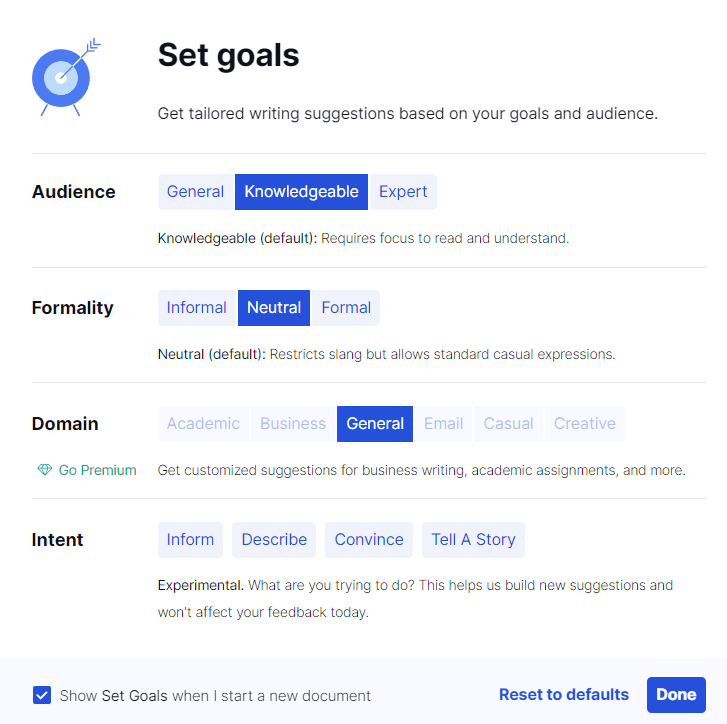
GrammarlyGO uses these goals to assess the effectiveness of your text. This evaluation looks at four criteria: Correctness, Clarity, Engagement, and Delivery. You can click on Correctness or Clarity to view relevant suggestions, but Engagement and Delivery suggestions are restricted to premium users.
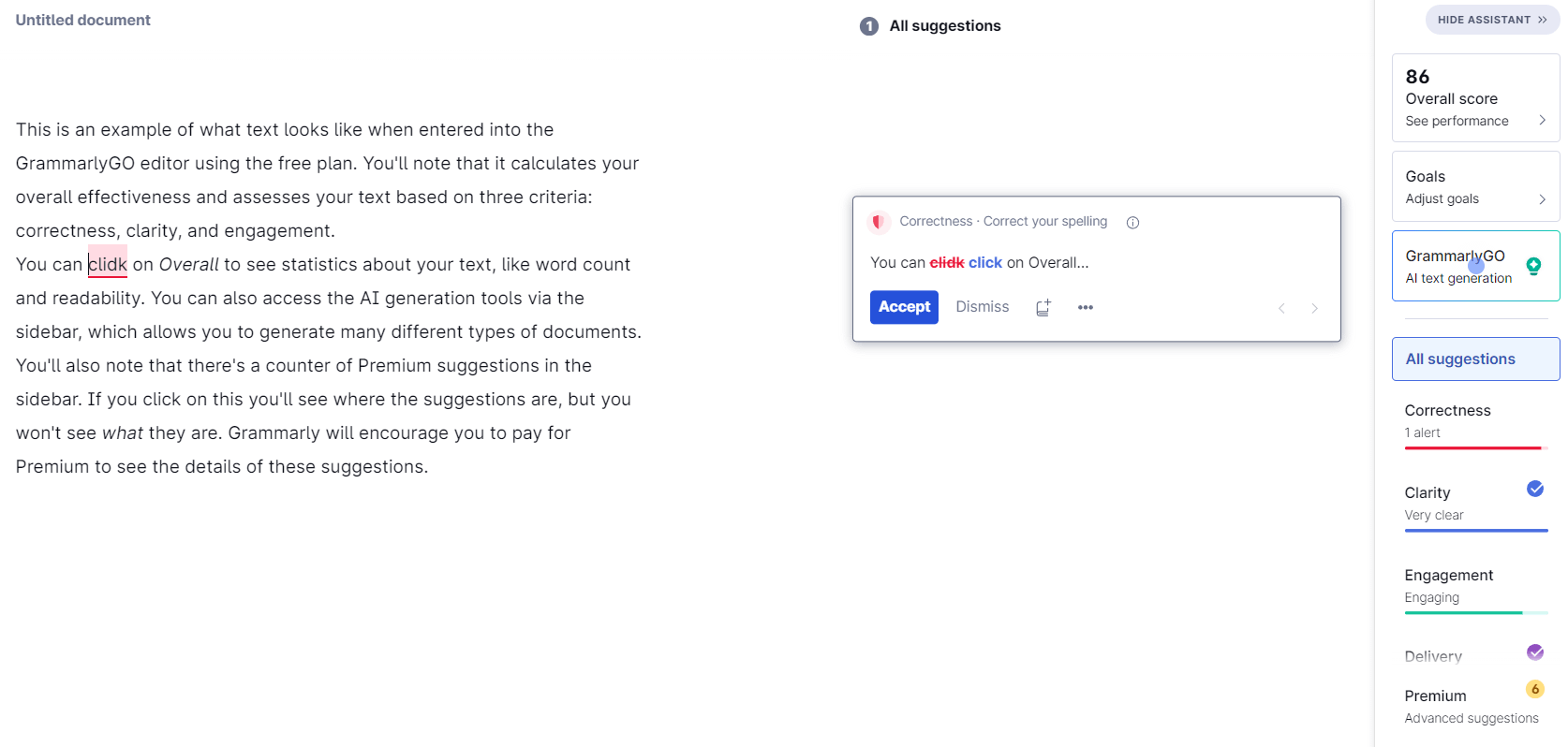
The Overall score area will show you key metrics of your text, like word count and readability.
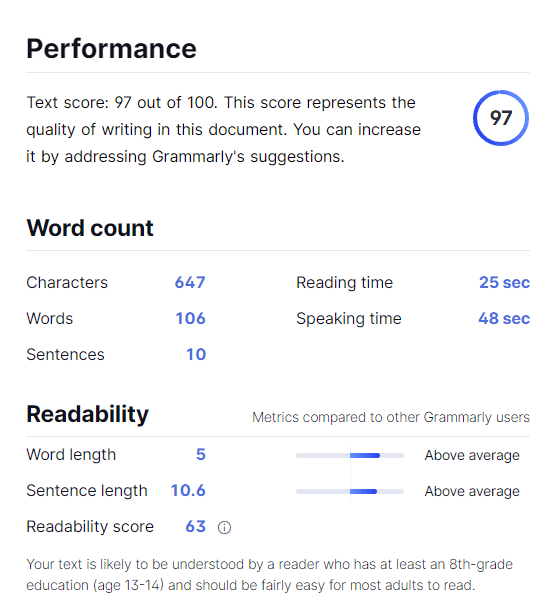
You’ll also find Grammarly’s AI text generation tool in the GrammarlyGO sidebar. This tool can create numerous types of documents, including blog post ideas, introductory emails, and business proposals. All you need to do is select a document type and enter some basic information – Grammarly will tell you what it needs. Grammarly will then use your prompts to create a full document:
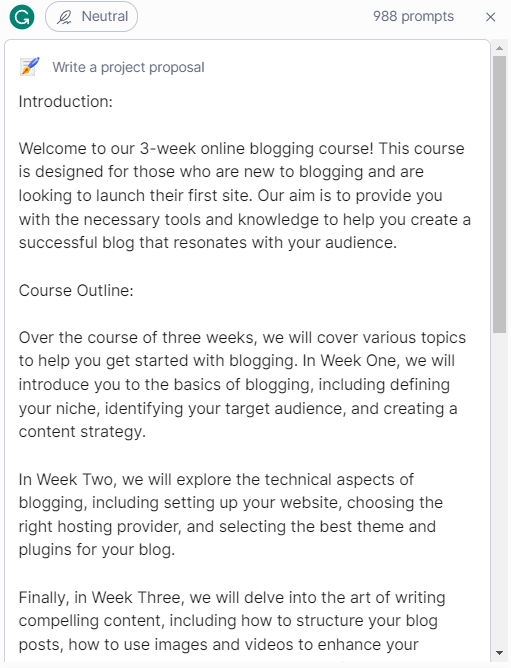
Grammarly Premium
On a basic level, Grammarly Premium works the same way as the free Grammarly software. You can either connect it to your writing program or write directly in GrammarlyGO. There are some key differences, though.
For starters, Grammarly Premium assesses your text for engagement as well as clarity. The engagement notes focus on things like switching out repetitive words and varying sentence structure to make the text less monotonous. These suggestions are underlined in green.
Unfortunately, Grammarly Premium’s advanced suggestions don’t always show up in blogging software or something like Google Docs. If you want to make sure you’re seeing every suggestion, you’ll need to work in GrammarlyGO. This is often a better option anyway, though, since you’ll be able to see Grammarly’s full assessment of your work in the sidebar.
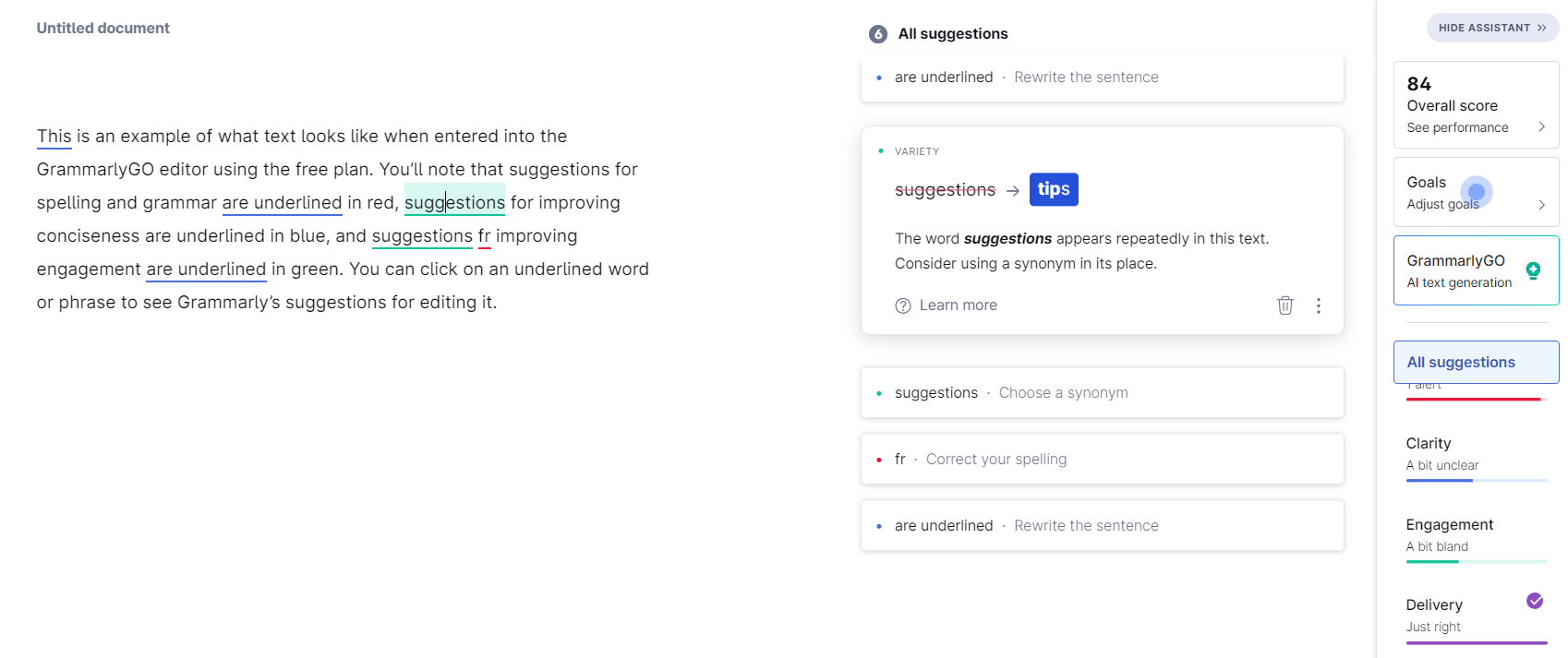
Another difference in the premium version of GrammarlyGO is that the Goals area now lets you choose a Domain. This isn’t the domain of a website you’re working on; rather, it’s the type of publication you’re writing for. Categories include Academic, Business, General, and Email. Grammarly will use the domain you’ve selected to provide specific tone suggestions.
The other goals are the same for most domains, but the Academic domain comes with its own set of goals:
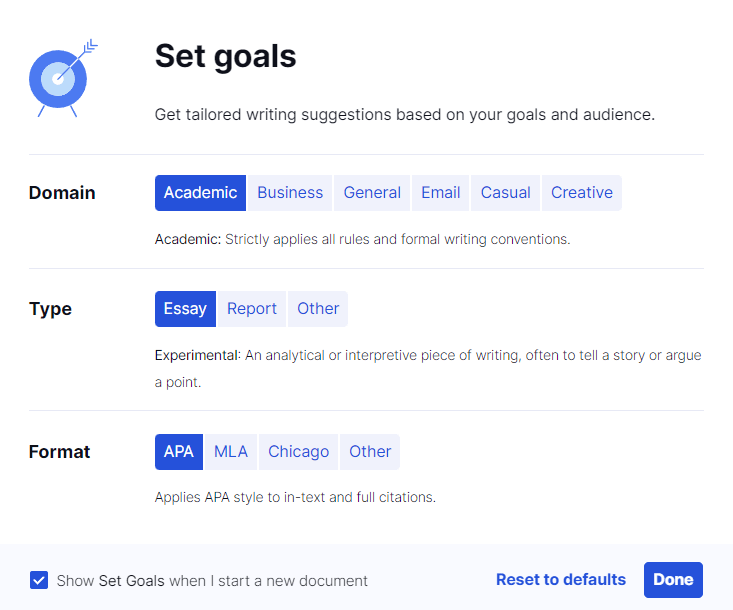
This allows you to get more specialized suggestions for essay or report-style writing, plus automatic corrections to make sure all citations are formatted properly. The latter can be especially helpful if you’re writing for a publication that uses a citation format you haven’t used much.
Apart from these differences, using Grammarly Premium is essentially the same as using the free version of Grammarly. This includes the use of the AI tools, which can still be accessed in two ways:
- Highlighting specific text and clicking Improve it
- Clicking on the GrammarlyGO AI text generation button in the sidebar of GrammarlyGO
The big difference is that you’ll get 1,000 AI prompts per month, so you’ll be able to rewrite many sentences and generate numerous pieces of new content each month.
Ease of use/interface: the winner 🏆
So what’s the winner of this section of the debate of Grammarly free vs premium?
When it comes to ease of use, the free version of Grammarly comes out slightly ahead because all of its suggestions show up reliably in blogging software and other writing tools. However, if you want to enter goals for a piece to get a more customized assessment, you’ll need to use GrammarlyGO.
Choosing a winner for the interface is more difficult. On one hand, the free version of Grammarly integrates more efficiently with your existing writing software. On the other hand, the GrammarlyGO interface is more robust and effective if you’re using Grammarly Premium. To me, this makes it a tie, with the winner depending on how you want to use Grammarly.
Pricing 💳
The final thing to consider in the debate about Grammarly free vs premium is the cost.
The free version of Grammarly is, well, free. You’ll never be expected to pay anything.
👉 Grammarly Premium, on the other hand, has two price tiers:
- Premium. This plan has all of the features we discussed in the Grammarly Premium sections of this article and is available for $12 per month.
- Business. This plan has the features we discussed, plus the option to create a Style Guide used to create customized writing assessments in GrammarlyGO. You’ll pay $15 per member per month on this plan.
Premium plans can be purchased on a monthly, quarterly, or annual basis.
Pricing: the winner 🏆
If you’re on a tight budget, the free version of Grammarly is the clear winner of this part of the Grammarly free vs premium debate.
If you’ve got some money to invest in improving your writing, however, Grammarly Premium is quite affordable. And if you’re a business that hires writers, the Business plan is also reasonably priced.
Security: what happens with your data 🛡️
Privacy is incredibly important, especially if you’re working with sensitive personal information or clients who require NDAs.
Unfortunately, this is one area where Grammarly isn’t great. All content you create while using Grammarly will be used to train the Grammarly AI. There’s no way to opt out unless you’re an enterprise managing over 500 accounts.
Grammarly does claim to have protocols in place to anonymize data and protect your privacy, but there are some questions about how effective these measures are. This means you’ll want to avoid Grammarly if you work with NDAs or sensitive information. You may also want to avoid Grammarly if you have ethical concerns about the way current AI technology is trained.
The final verdict on Grammarly free vs Premium 👨⚖️
So, what’s the winner in the debate of Grammarly free vs premium?
Well, it depends on your goals. 🎯
If you want simple grammar and spelling suggestions directly in your preferred writing software, the free version of Grammarly is best for you.
If you want the advanced writing assessments provided by GrammarlyGO, you should invest in Grammarly Premium so you can access all of GrammarlyGO’s best features. Grammarly Premium is also the best choice if you want to use AI to rewrite and/or create a significant amount of content.
On the other hand, if you’re concerned about data privacy, 🔒 you might want to check out our list of Grammarly alternatives.
What Grammarly plan are you most interested in? Let us know in the comments section below!